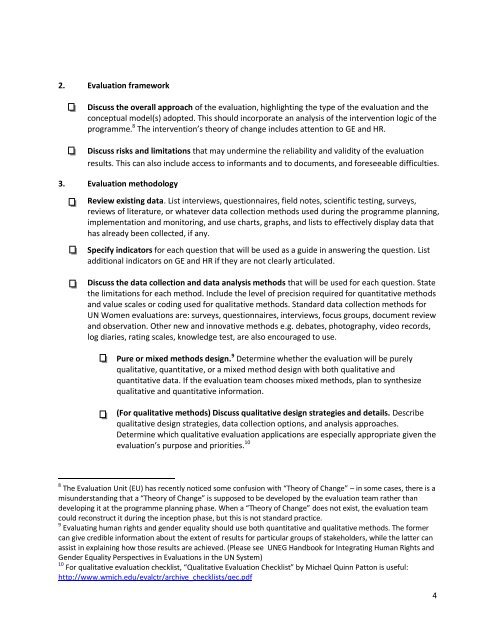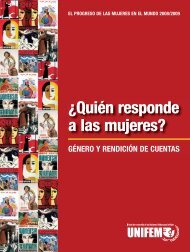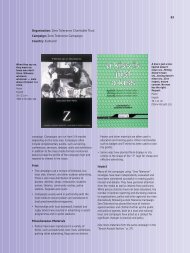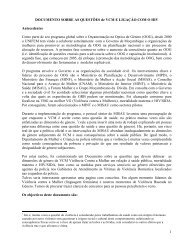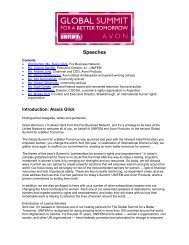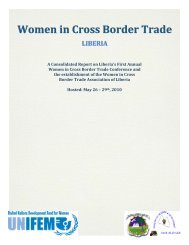Guidance note for Inception Reports - UN Women
Guidance note for Inception Reports - UN Women
Guidance note for Inception Reports - UN Women
Create successful ePaper yourself
Turn your PDF publications into a flip-book with our unique Google optimized e-Paper software.
2. Evaluation framework<br />
2 Evaluation f<br />
Discuss the overall approach of the evaluation, highlighting the type of the evaluation and the<br />
conceptual model(s) adopted. This should incorporate an analysis of the intervention logic of the<br />
programme. 8 The intervention’s theory of change includes attention to GE and HR.<br />
Discuss risks and limitations that may undermine the reliability and validity of the evaluation<br />
results. This can also include access to in<strong>for</strong>mants and to documents, and <strong>for</strong>eseeable difficulties.<br />
3. Evaluation methodology<br />
Review existing data. List interviews, questionnaires, field <strong>note</strong>s, scientific testing, surveys,<br />
reviews of literature, or whatever data collection methods used during the programme planning,<br />
implementation and monitoring, and use charts, graphs, and lists to effectively display data that<br />
has already been collected, if any.<br />
Specify indicators <strong>for</strong> each question that will be used as a guide in answering the question. List<br />
additional indicators on GE and HR if they are not clearly articulated.<br />
Discuss the data collection and data analysis methods that will be used <strong>for</strong> each question. State<br />
the limitations <strong>for</strong> each method. Include the level of precision required <strong>for</strong> quantitative methods<br />
and value scales or coding used <strong>for</strong> qualitative methods. Standard data collection methods <strong>for</strong><br />
<strong>UN</strong> <strong>Women</strong> evaluations are: surveys, questionnaires, interviews, focus groups, document review<br />
and observation. Other new and innovative methods e.g. debates, photography, video records,<br />
log diaries, rating scales, knowledge test, are also encouraged to use.<br />
Pure or mixed methods design. 9 Determine whether the evaluation will be purely<br />
qualitative, quantitative, or a mixed method design with both qualitative and<br />
quantitative data. If the evaluation team chooses mixed methods, plan to synthesize<br />
qualitative and quantitative in<strong>for</strong>mation.<br />
(For qualitative methods) Discuss qualitative design strategies and details. Describe<br />
qualitative design strategies, data collection options, and analysis approaches.<br />
Determine which qualitative evaluation applications are especially appropriate given the<br />
evaluation’s purpose and priorities. 10<br />
8 The Evaluation Unit (EU) has recently noticed some confusion with “Theory of Change” – in some cases, there is a<br />
misunderstanding that a “Theory of Change” is supposed to be developed by the evaluation team rather than<br />
developing it at the programme planning phase. When a “Theory of Change” does not exist, the evaluation team<br />
could reconstruct it during the inception phase, but this is not standard practice.<br />
9 Evaluating human rights and gender equality should use both quantitative and qualitative methods. The <strong>for</strong>mer<br />
can give credible in<strong>for</strong>mation about the extent of results <strong>for</strong> particular groups of stakeholders, while the latter can<br />
assist in explaining how those results are achieved. (Please see <strong>UN</strong>EG Handbook <strong>for</strong> Integrating Human Rights and<br />
Gender Equality Perspectives in Evaluations in the <strong>UN</strong> System)<br />
10 For qualitative evaluation checklist, “Qualitative Evaluation Checklist” by Michael Quinn Patton is useful:<br />
http://www.wmich.edu/evalctr/archive_checklists/qec.pdf<br />
4


